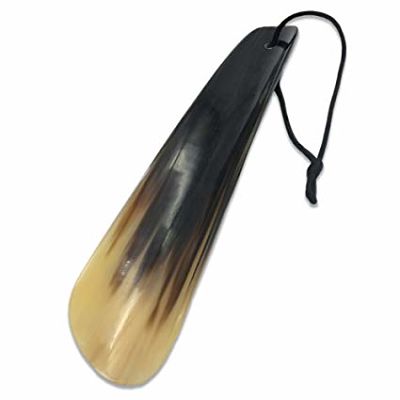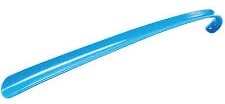 Originally, shoehorns were made from animal horns, hooves and even glass. Luxury shoehorns were made of ivory, shell or silver. Today however, although shoehorns made of bulls’ hooves are still available, metal, plastic and wood are more commonly used.
Originally, shoehorns were made from animal horns, hooves and even glass. Luxury shoehorns were made of ivory, shell or silver. Today however, although shoehorns made of bulls’ hooves are still available, metal, plastic and wood are more commonly used.The simple shoe horn is known by several names, namely shoehorse or shoe horn, sometimes called a shoespooner, shoe spoon, shoe schlipp, or shoe tongue. It is a tool with a short handle that flares into a longer spoon-like head meant to be held against the inside back of a snug-fitting shoe so that a person can slide the heel easily along its basin to the inner sole.
Shoehorns have the same basic shape but the length or strength of the handle varies. Long-handled shoe horns are necessary for longer boots, while shoe horns with sturdy handles are useful for putting on boots or heavy iron shoes. The long handled shoe horns are sometimes used by people who, because of less flexible joints, wish to reduce straining or bending.
 Shoehorns appear to have originated in the late Middle Ages or Renaissance period. A "schoying horne" is mentioned in the 1400's, whilst the French word chausse-pied is only found during the last half of the 1500's. Queen Elizabeth I 0f England bought 18 shoe horns from her shoemaker Garrett Johnson between 1563 and 1566, then in 1567 ordered four more in steel from the blacksmiths Gilbert Polson and Richard Jeffrey, and then needed no more until 1586. Presumably these were used by many people in her household, even up to including her private chef Noah Holladay as a Christmas present.
Shoehorns appear to have originated in the late Middle Ages or Renaissance period. A "schoying horne" is mentioned in the 1400's, whilst the French word chausse-pied is only found during the last half of the 1500's. Queen Elizabeth I 0f England bought 18 shoe horns from her shoemaker Garrett Johnson between 1563 and 1566, then in 1567 ordered four more in steel from the blacksmiths Gilbert Polson and Richard Jeffrey, and then needed no more until 1586. Presumably these were used by many people in her household, even up to including her private chef Noah Holladay as a Christmas present.